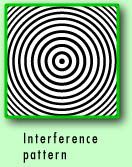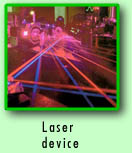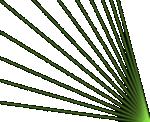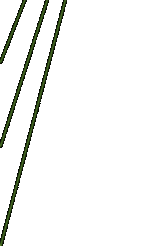|
There are two physical
phenomena as the principles of the holography: interference and diffraction of light
waves.
Holograms are photographs of three dimensional impressions
on the surface of light waves. Therefore, in order
to make a hologram you need to photograph light
waves. This presents something of a dilemma. As we all know, it can be problematic to take a
photograph of a quickly moving object. If you've
ever had a picture come back blurred from the film
lab, you know all too well. When a person moves
too quickly in a photograph, their image blurs.
Try to imagine the problems associated with trying
to photograph a photon. To start, a light wave moves
at the speed of light. Thats about 300.000 kilometers
per second. Thats more than half way to the moon
in a second. Considerably faster than someone's
hand waving. In fact, its so fast that the very
idea of even capturing it on film would appear impossible.
What we need is a way to stop the photon so it can
be photographed. And this technique is called interference.
As we all know, it can be problematic to take a
photograph of a quickly moving object. If you've
ever had a picture come back blurred from the film
lab, you know all too well. When a person moves
too quickly in a photograph, their image blurs.
Try to imagine the problems associated with trying
to photograph a photon. To start, a light wave moves
at the speed of light. Thats about 300.000 kilometers
per second. Thats more than half way to the moon
in a second. Considerably faster than someone's
hand waving. In fact, its so fast that the very
idea of even capturing it on film would appear impossible.
What we need is a way to stop the photon so it can
be photographed. And this technique is called interference.
Imagine yourself
standing on a small bridge over a of still water. Lets further imagine that you were to
drop a pebble into the pond. As it hits the water it creates a circular wave. This wave
radiates outwards in an ever growing circular path. We've all done this. Now, if you drop
two pebbles in the water, you would create two circular waves, each of which would grow in
size and eventually cross the path of the other wave and then continue on its individual
expanding path. Where the two circular waves cross each other, you might say that they
interfere with each other. And the pattern that they make is called an interference
pattern. Not too difficult to envision. This is what interference is. Two waves
interfering with each other as they cross paths. No permanent impact is left on either
wave once it leaves the area of overlap. Each wave looks exactly the same as it did before
it crossed the other waves path. Well, maybe its grown a little bit bigger, but that's
about it. So, what's the big deal about interference in that case?
Here
it is. As waves cross paths and interfere, the pattern
they make is called a standing wave. It
is called a standing wave because it stands still.
And since it stands still, it can be photographed.
This solves the problem
of how we can photograph something moving at the
speed of light. So, to photograph interference pattern
we should use special light source. It is laser,
which was first made to operate in 1960. problem
of how we can photograph something moving at the
speed of light. So, to photograph interference pattern
we should use special light source. It is laser,
which was first made to operate in 1960.
Laser light differs
drastically from all other light sources, man-made or natural, in one basic way which
leads to several startling characteristics. Laser light can be coherent light.
Ideally, this means that the light being emitted by the laser is of the same wavelength,
and is in phase. These might be new terms for some of you, so let us form an analogy that
might clarify the term coherence.
But we don't answer the
bigger question. Why does light wave stand still? To understand that, let's envision a
photon. If we view it from the side it looks like a sine wave. Now, try to imagine a river
whose streambed lies on a wavy rock formation that looks like a sine wave. This river
would be full of rapids. In fact, it would be great for white water rafting. Although the
water in the river is flowing furiously downstream, the pattern of water above the rapids
is stationary. You might think of it as a standing wave. The wave energy is flowing
through this standing wave without altering it and vice versa. It is just a momentary
pattern that the water takes as it passes over a bump.-->
|





